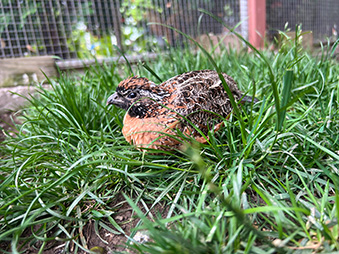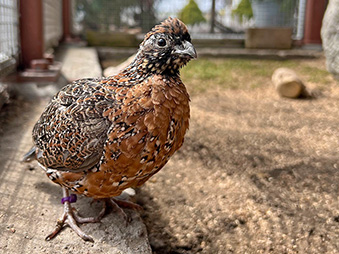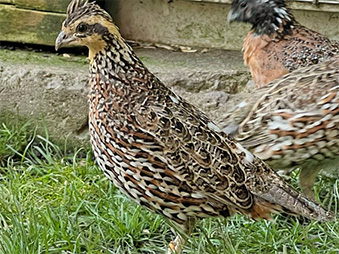Colinus virginianus ridgwayi | Masked Bobwhite Quail
Names:
- Male: Heath & York
- Female: Buncha Crunch & Dot



Meet York, Dot, Buncha Crunch & Heath
Small, secretive, and critically endangered, the Masked Bobwhite Quail is one of the rarest birds in North America—and you're lucky enough to meet five of them right here at the Zoo! Our flock includes both males and females, representing a variety of ages, just like you’d see in a wild covey.
You can find them on the back side of the Rainforest building, next to the chicken habitat—often taking a dust bath in their favorite enrichment: fresh sand!
What Makes a Bobwhite Masked?
This special subspecies of the northern bobwhite is uniquely adapted to the Sonoran Desert, a dry and demanding region along the U.S.–Mexico border. Once widespread in southern Arizona and Mexico, wild masked bobwhites now only survive on a single wildlife refuge.
- Males have striking black “masks" and a warm chestnut-colored breast.
- Females wear softer, speckled tones for better camouflage.
Masked bobwhites live in social groups called coveys, foraging together and sticking close to dense, low vegetation that offers both cover and food.
Breeding in the Desert: It's All About the Rain
Masked bobwhites don’t follow a strict breeding calendar. Instead, they wait for moisture, which is rare in their native range. Nesting is most successful at the start of spring and during the summer monsoon season.
During these brief windows of abundance, pairs break away from their covey to nest and raise young. Each pair typically produces a brood of around 11 chicks, and both parents help incubate and care for the young—a rare trait among ground-dwelling birds!
Chicks are precocial, meaning they can walk and find food shortly after hatching—but they’re born with only soft down feathers and can't regulate their body temperature. That means they must stay close to their parents until their adult feathers come in.
It takes about five weeks before the young are ready to rejoin the covey, making family cooperation a big part of this species' survival.
Fact Sheet
Taxonomy
Genus: Colinus | Species: Colinus | Subspecies: ridgwayi |
Kingdom: Animalia | Phylum: Chordata | Class: Aves | Order: Galliformes | Family: Odontophoridae |
Favorite Enrichment Type
Fresh sand to dust-bathe in!
Life Span
- In the Wild: 8 to 12 months
- In Human Care: Up to 5 years
Diet
- In the Wild: Seeds, insects, and plants.
- At the Zoo: Mazuri® Gamebird Diet, greens, insects, fruit and vegetables.
Geographic Range
Found on the Buenos Aires National Wildlife Refuge, located in Sonoran Desert of southern North America near the U.S.-Mexico border region. Wild populations have not been observed since 2007.
Habitat
Sonoran Desert and semi desert regions.
Masked Bobwhite Fast Facts
- Buenos Aires National Wildlife Refuge: Once found in southern Arizona and Mexico—now only on one refuge.
- Size: Tiny! Just 5–6 inches tall.
- Covey: Live in coveys with both males and females.
- Sexual Dimorphism: Males have bold black “masks,” females are speckled for camouflage.
- Clutch Size: Average brood size: 11 chicks.
- Parental Care: Both parents incubate and raise their young.
- Critically Endangered: No wild sightings outside refuge since 2007.
Status: Critically Endangered
A Closer Look at Overgrazing: The Silent Threat
You’ve probably read that habitat loss is one of the biggest challenges facing wildlife—but what does that really mean?
For the masked bobwhite, one of the most damaging forces has been overgrazing by livestock. But this problem runs deeper than just a few too many cattle in the wrong place.
Let's Break It Down:
What is Overgrazing
Overgrazing happens when livestock graze the same area for too long, not giving native plants time to recover. It’s not about how much the animals eat—it’s about how frequently they return to the same spot.
The Domino Effect of Overgrazing:
Soil Damage
When grasses are grazed down too quickly:
- Soil becomes exposed and compacted.
- Water can’t soak in and runs off.
- Microbial life that supports plant growth disappears.
Plant Damage
Native plants need time to:
- Regrow leaves
- Develop strong roots
- Produce seeds
Without recovery time, they die off—taking food and shelter for wildlife with them.
Water Polution
More livestock = more waste. Excess nutrients and manure get washed into nearby lakes and streams, increasing nitrogen and phosphorus to unsafe levels, and potentially spreading disease to native species.
Invasive Plant Takeover
When native plants are wiped out, tough, inedible species take over. These “survivor” plants:
- Have thorns or spikes.
- Offer little to no value to native animals like the masked bobwhite.
- Are invasive and detrimental to the overall ecosystem.
This lowers biodiversity and weakens the entire ecosystem.
Why It Matters
Masked Bobwhites Need:
- Native grasses for cover.
- Insects and seeds for food.
- Stable, untrampled ground to nest and raise their chicks.
Overgrazing erodes all three—which is why protecting and restoring their habitat is a vital part of their survival.
Conservation in Action
- Wild masked bobwhites haven’t been seen outside of the Buenos Aires National Wildlife Refuge since 2007, but there’s still hope.
- Habitat restoration.
- Ethical breeding programs.
- Reintroduction programs.
the U.S. Fish & Wildlife Service, as well as several AZA-accredited zoos are working to bring this bird back from the brink.
What You Can Do to Help
- Support habitat restoration – Healthy grasslands = thriving wildlife.
- Share their story – Many people have never heard of the masked bobwhite.
- Advocate for sustainable land management – Proper management now = a sustainable future for wildlife and people.
- Support AZA institutions – Your visit funds critical conservation work.
- Reduce plastic use & chemical runoff – Protect water for all life.
Every action, no matter how small, makes a difference. Let’s work together to bring the masked bobwhite home again.
How to Find Us
Check out our critically endangered masked bobwhites on the back side of the Rainforest building, located next to the chicken habitat. These five little birds may not be flashy, but their story shines a bright light on the ripple effects of habitat change—and the hope that conservation efforts can still inspire!
